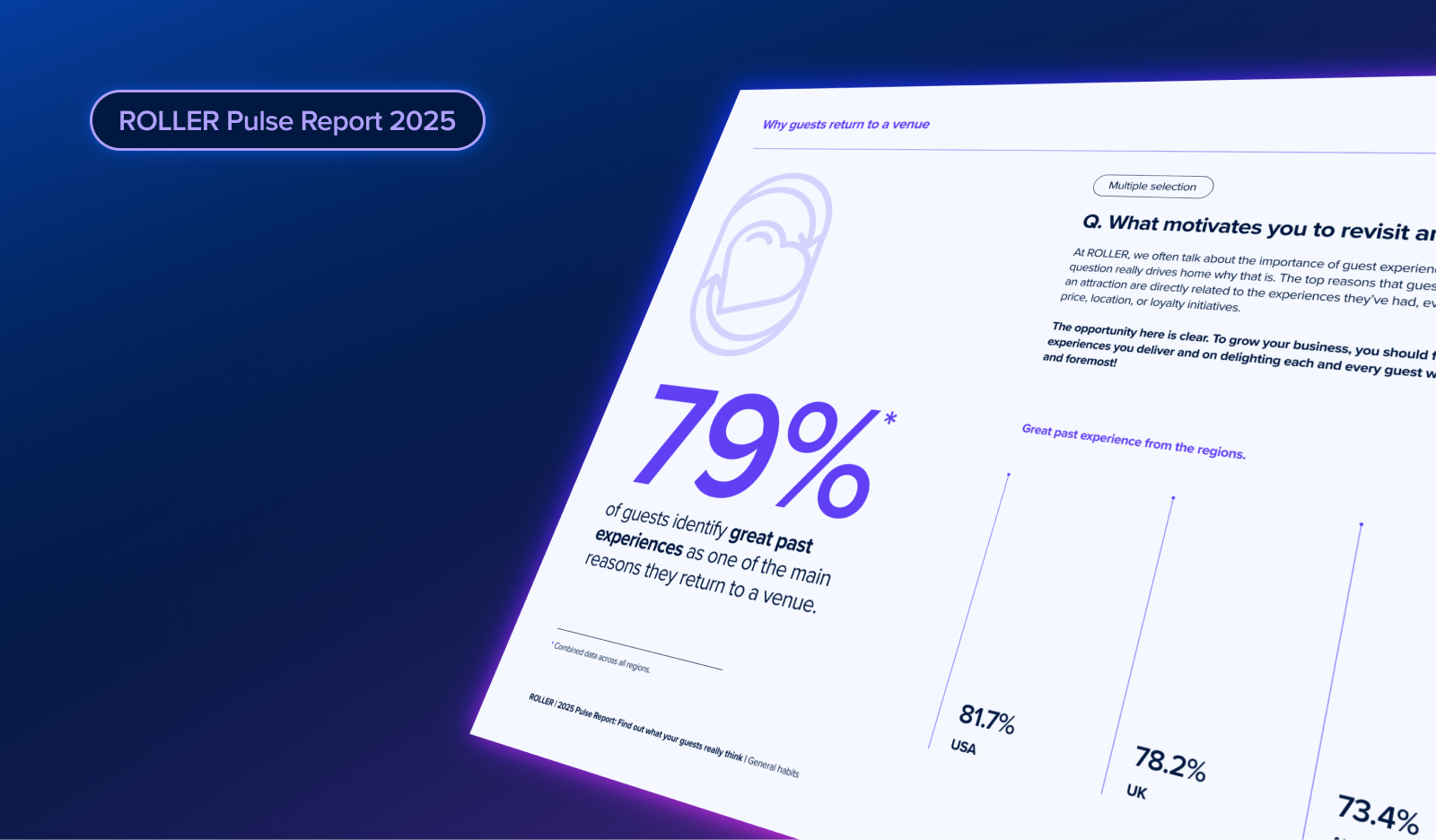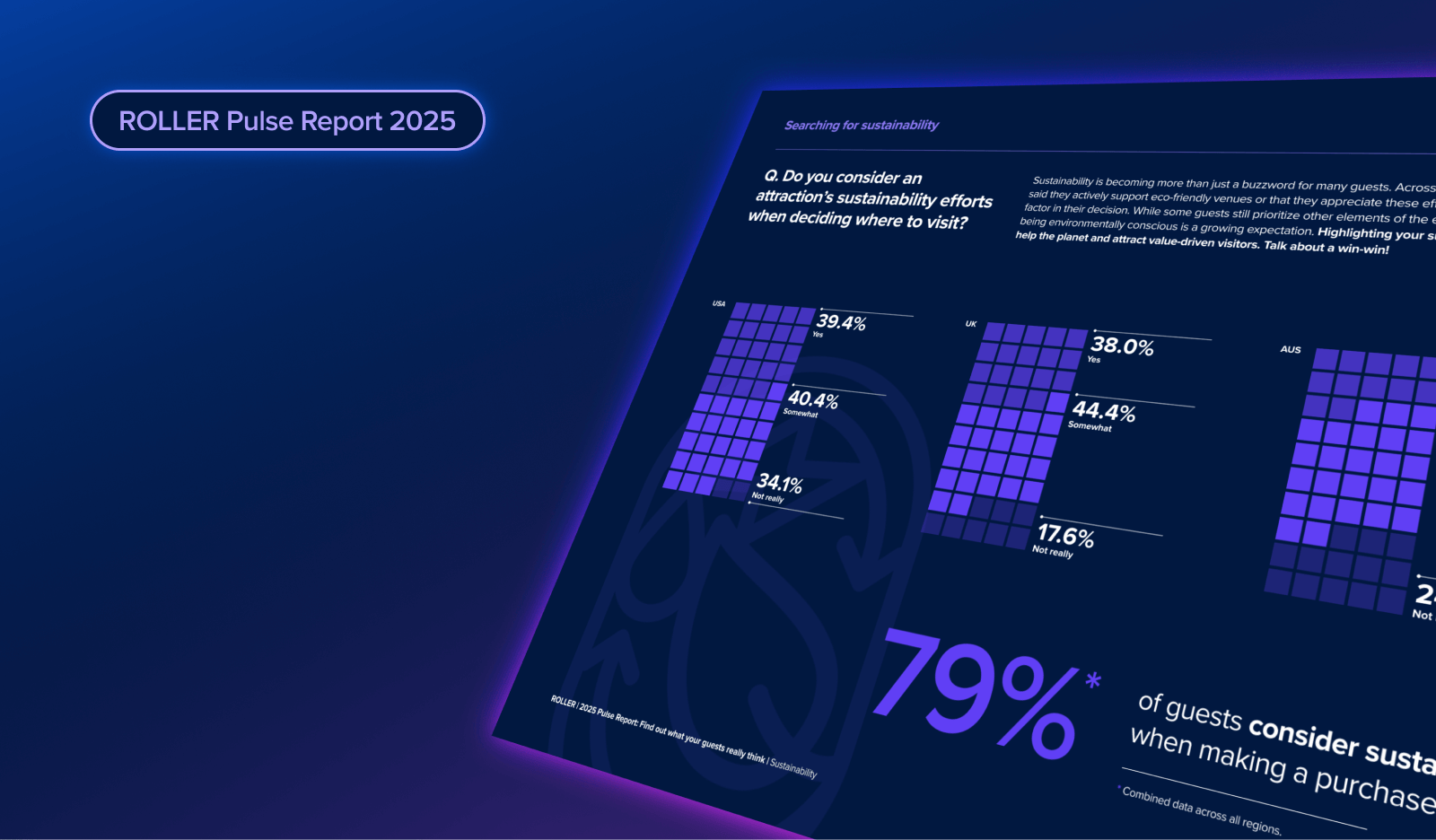Mastering the Peak-End Rule: A Guide for Operators to Elevate Visitor Experiences
.png?width=820&name=Mastering%20the%20Peak-End%20Rule_%20A%20Guide%20for%20Attraction%20Venue%20Owners%20to%20Elevate%20Visitor%20Experiences_Social(2_1).png)
Imagine a family driving home after a day at a theme park. Their conversation likely centers around two key moments: the exhilarating climax of the roller coaster ride and the delight of a fireworks show at the end of the day. Why these two moments when the day was packed with so much more? This is where the peak-end rule, a powerful psychological principle that can transform how visitors perceive and remember their experiences at your venue, comes into play.
Unpacking the peak-end rule
The peak-end rule — a concept introduced by psychologists Daniel Kahneman and Barbara Fredrickson — suggests that people judge an experience mainly by how they feel at its most intense point (the peak) and its end. This rule is rooted in how our memory works; it's not a video recording every second but a highlight reel focusing on significant moments.
To help gain an understanding of the psychological mechanisms behind the peak-end rule, here is a basic breakdown:
Emotional memory formation
- Intensity vs. duration: The intensity of an experience, rather than its duration, is more likely to influence memory formation.
- Emotional peaks: Peak moments that evoke strong emotions are more easily encoded into long-term memory.
Cognitive biases and perception
- Recency effect: The recency effect (our tendency to remember the latest parts of an experience) plays a pivotal role in what gets cemented in our memory.
- Narrative construction: People construct narratives of their experiences, often focusing on peaks and ends to form a coherent story.
The peak-end rule: How it can impact your attraction?
For attraction venue operators, understanding and applying the peak-end rule is not just a psychological exercise; it's a strategic tool for enhancing guest satisfaction and loyalty. By creating standout peak moments and memorable endings, you can shape how visitors remember their day at your venue, encouraging repeat visits and positive word-of-mouth.
Understanding the peak-end rule provides insights into what makes an experience memorable for visitors. For example, a theme park might focus on ensuring that their most thrilling ride (the peak) and the exit experience (the end) are extraordinary, as these will be the most remembered aspects of the visit.
Similarly, consider a zoo where the peak is a hands-on animal encounter, and the end is a personalized memento given to visitors. Despite any hiccups during the day, these moments are likely to dominate visitors’ memories, leading to higher overall satisfaction and the likelihood of recommending the venue to others.
Identifying peak experiences at your venue
To optimize your key attractions for peak experiences, focus on elements that elevate the emotional impact. This can be achieved through storytelling, incorporating technology for immersive experiences, or adding personal touches that resonate with visitors. For example, a story-driven haunted house experience with interactive elements can transform a typical walkthrough into a memorable adventure. Here are some top tips:
- Emotionally engaging: The experience should create a deep emotional connection, evoking feelings like excitement, joy, or wonder.
- Unique: Offer a distinctive experience that sets your venue apart from others.
- Exhilarating: Include elements that provide a rush of adrenaline or surprise, elevating the experience from the ordinary.
- Memory anchors: Consider how certain elements, like unique visuals, sounds, and even smells, can serve as memory anchors, reinforcing the recollection of peak and end experiences.
Enhancing key attractions for peak experiences
Innovation and uniqueness are crucial in setting your peak experiences apart from the competition. They add an element of surprise that can turn a great experience into an unforgettable one. Consider integrating the latest technology, like virtual reality, to create a unique, immersive experience that can’t be found elsewhere. Or, introduce a seasonal event with a unique theme that captivates your visitors’ imagination.
Amplify unique elements
- Identify signature attractions: Determine what attractions or features are unique to your venue and focus on enhancing these. For example, if your venue is known for its historic train rides, consider adding themed journeys or special events aboard the train.
- Emphasize local culture or history: If your venue has a rich cultural or historical background, use this to create unique storytelling experiences. For example, a museum could offer interactive exhibits featuring local legends or history.
- Create signature events: Develop special events that highlight the unique aspects of your venue, like a night-time garden party in a botanical garden showcasing rare plants.
Personalize experiences
- Interactive personalization: Offer interactive experiences that adjust based on visitor choices, like a choose-your-own-adventure tour.
- Targeted experiences for different demographics: Develop different experience paths or activities tailored for children, adults, or specific interest groups. For example, a wildlife park could offer an educational trail for kids and a more in-depth ecological tour for adults.
- Customizable souvenirs: Provide personalized mementos, like custom-printed photos or engravings, that visitors can take home as a unique reminder of their experience.
Innovative use of space and technology
- Transformative use of space: Utilize your venue's space in innovative ways. For example, an outdoor venue could create an immersive light and sound show in the evenings, transforming the same space into a different world.
- Leverage emerging technologies: Incorporate technologies like VR (Virtual Reality) or AR (Augmented Reality) to create immersive experiences. For instance, a historical site could use AR to show historical events unfolding as visitors walk through.
- Interactive installations: Create installations that interact with visitors’ actions or movements, such as motion-sensing games or exhibits that change based on visitor input.
Examples of attractions enhanced for peak experiences
- In a historic mansion venue, a dramatic reenactment in the grand ballroom, or a secret room tour revealing untold stories.
- Inside an aquarium, a diver’s tour in the main tank or a hands-on encounter with sea creatures.
- In a botanical garden, a guided night walk highlighting rare nocturnal blooms.
- At a science museum, an interactive lab where visitors participate in exciting experiments.
Ensuring a positive end
The end of a visitor's experience at your venue is often the most recent memory they will carry with them, and as per the peak-end rule, it significantly influences their overall perception of the visit. A positive ending can transform a good experience into an exceptional one, prompting visitors to share their experiences enthusiastically and return in the future.
Below are some ways to enhance the end of a visitor's journey:
- Thoughtful farewells: Train your staff to offer warm, personalized farewells. For instance, mentioning a highlight the visitor experienced earlier in the day shows attentiveness and care.
- Personalized recommendations for future visits: Offer suggestions for future activities or events based on the visitor's interests shown during their current visit. This can create a sense of personal connection and anticipation for their next visit.
- Memorable parting gifts: Offer a small parting gift or souvenir, like a customized badge or a photo from their visit, as a tangible reminder of their experience.
- Ease of exit: Ensure the exit process is smooth and hassle-free, whether it's guiding visitors through the exit, managing parking lot flow, or providing clear directions.
Incorporating surprise and delight
Integrating unexpected elements of surprise and delight as visitors conclude their visit can turn a positive experience into an extraordinary one. These surprises should be pleasant, memorable, and align with the overall theme of your venue.
Examples of successful surprise and delight tactics:
- Unexpected entertainment: For example, a flash mob performance near the exit or a surprise appearance by a character related to the attraction. Or for special occasions and events, consider organizing a celebratory send-off, like a small fireworks display or a live music performance near the exit.
- Interactive exits: Incorporate engaging activities in the exit pathway, like a photo booth with themed props or an interactive display where visitors can see a summary of the day’s highlights or leave feedback.
- Post-visit communication: Follow up their visit with a thank you email, including a photo or video from their day, enhancing the positive memories of their experience.
- Final impressions through environment: Pay attention to the environmental details of the park. Utilize other senses like touch and smell. For example, the use of a unique fragrance in a specific part of the experience, or a tactile interactive element, can leave a lasting sensory impression.
By focusing on designing memorable endings and incorporating surprise and delight tactics, venue operators can ensure that the final moments at their attractions leave a lasting positive impression, turning visitors into enthusiastic advocates and repeat customers.
Applying the rule to operations
Successfully implementing the peak-end rule isn't just about crafting individual experiences; it's also about integrating this principle into the operational framework of your venue. Aligning staff training and other operational elements with this psychological principle can impact peak and end experiences.
How operational decisions impact peak and end experiences
Operational decisions, from staffing to maintenance schedules, are critical in ensuring the consistency and quality of peak and end experiences. For example, ensuring that your most popular attractions are well-staffed and efficiently run can significantly enhance the peak experience. Similarly, maintaining cleanliness and order, especially towards the end of the visit, can positively influence guests' final impressions. Here are some tips:
- Empower staff to create peaks: Train your staff to recognize opportunities to create peak moments. This could be as simple as a staff member going out of their way to help a guest or providing unexpected insights during a tour.
- Emphasis on farewells: Educate staff on the importance of the end of the visitor experience. Encourage them to offer personalized goodbyes when possible or assist in creating a smooth and pleasant departure process.
- Consistent quality service: Ensure all staff understand the importance of consistent service quality throughout the visitor experience, as this sets the stage for both peak and end moments.
Leveraging seasons and events to enhance the peak-end effect
Seasonal changes and special events provide unique opportunities to enhance the Peak-End Effect. By aligning attractions or experiences with seasons or special events, you can create fresh and memorable peak moments that resonate with the current time of year or occasion.
Impact of themed events and limited-time experiences:
- Themed events: Hosting themed events, like a Halloween haunted house or a summer festival, can create new peak experiences that are timely and exciting. These events can offer unique experiences that differ from the everyday offerings of your venue.
- Limited-time experiences: Limited-time attractions or experiences create urgency and exclusivity, making them natural peak moments. For example, a once-a-year night-time tour or a special exhibit can attract repeat visitors and generate buzz.
Crafting unforgettable experiences with the peak-end rule
The peak-end rule offers a valuable lens through which attraction venue operators can view and enhance their guests' experiences. The result? A venue that doesn't just attract guests but captivates them, creating stories and memories that are shared and cherished long after their visit has ended. In the competitive world of attraction venues, leveraging the peak-end rule isn't just good practice; it's essential for creating unforgettable experiences and building a loyal customer base.
Read this next: Seven Ways to Make Guests Feel Welcome at Your Entertainment Venue
Related articles

.png)
What the 2025 Pulse Report Reveals About Guest Booking Behavior at Attractions

2025 Pulse Report: How Sustainability Is Shaping Guest Expectations
Enhance your guest experience
Get free education, tips and inspiration to help you run a successful venue.